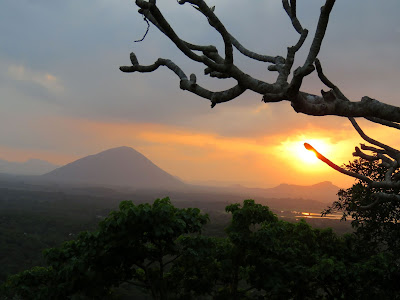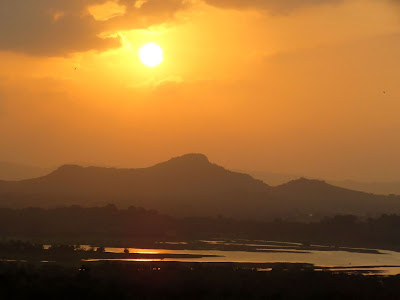
The most celebrated and famous Ranjiri Dambulla Rajamaha Viharaya Golden Temple and Rock Temple of Sri Lanka are located at the central part of the island 148 km away from its capital, Colombo. It is the largest and best preserved ancient edifice in the country that still remains as an active ritual center. The monastery with its five sanctuaries stands on a 500 feet high massive rock nearly 1200 feet above sea-level. The internal rock surfaces, ceiling, side walls of the caves are painted with intricate designs of Buddhist images with traditional indigenous colors in accordance to the contours of the rock. The five main caves namely Devaraja, Maharaja, Maha-alut, Pacchima and Devena Alut Viharaya house 157 Buddha images in various sizes and postures. The historical monastery site that dates back from first century BC has now established into an important Buddhist center in its nation and had been listed as one of the world heritage site of Unesco in year 1991.


The Caves Temple was first built during the reign of King Vattagamini Bhaya (103-89 BC) in first century BC. It was the place where King sought refuge from the invasion of South Indian for about 15 years. King Vattagamini after regaining his Kingdom, converted the caves into Buddhist Temples as an appreciation and gratitude to the place that offered him safety. He built wall partitions in the caves under a vast overhanging rock, made drip ledges along the caves to avoid rain water seeping into it and keep the interior dried. Cave Devaraja, Maharaja and Pacchima were constructed by him at that period.


After the death of King Vattagamini, the caves for centuries received no royal patronage until King Parakrama Bahu I (1123-1186) who moved his kingdom from Anuradhapura to Polonnaruwa. He did plenty of renovations to the caves, which at that time, had already tuned into the dwellings of monks. The caves were further improved by King Nissankamalala (1187-1196) who refurbished and gilded the interior sanctuaries. Many Buddha images were built and added into the caves and more than 50 Buddha Images were gold plated during his time. Another great ruler who did a great meritorious job to the cave temple was the Kandy King Keerthi Sri Rajasinghe (1747-1782). He restored, renovated and re-painted the cave monastery in 18th century.


Devaraja Lena is the first cave on the right hand side of the Bodhi Tree. Devaraja Lena means Temple for Lord of Gods. The main feature is the 45 feet long Reclined Buddha Image in his Parinirvana posture, with Ananda standing near his feet. The huge sleeping Buddha image was believed to be made around first century BC. The paintings were done during renovation within 17th to 18th century.



Some of the paintings had been faded mainly because of the incense and oil lamps used in early times,



The huge Reclined Buddha Image at Cave One and statue of King Vattagamini and King Nissankamalala at the entrance gate near Cave Two.



Maharaja Lena Cave 2 measured as 125 ft x 75 ft with height 21 feet is the largest and most impressive sanctuary. This Temple of Great Kings has large numbers of Buddha images in various postures either in the Mudra of Samadi, Abbaya, Varada or Vitarka. Hindu Gods Saman and Vishnu are also found being worshiped inside this cave.



The white Stupa in Cave 2 is surrounded by 11 seated Buddha images.


Some seated Buddha images are shaded with cobra heads above his top.


The life sized granite image of Buddha in Cave 2 is one of the gold gilded statues done by King Nissankamalla. The fascinating image is standing under a Makara Terana Dragon Arch, amidst in a group of many other images.


Murals at the rock ceiling and walls were painted with impressive designs and colors.


About 1500 Buddha seated images were painted on the rock ceiling.



The 32 feet long reclining Buddha image in The Great New Temple of Maha Alut Vinaraya (Cave 3) was carved out from a granite rock, reflecting the high level skill of Sinhala sculpture arts of that era.



The gorgeous geometrical designs at ceiling and seat base of reclined Buddha Image are colorful.


There are about 42 standing and 15 seated Buddha images in Cave 3, most of them were sculpted from granite.



The prominent seated Buddha image under dragon arch in the center of Cave 3 was surrounded by about 50 images of Buddha .


Cave 3 covering an area of 90x80x36 feet in height, was built by Kandy King Sri Rajasinha in 18th century.


Rows of seated Buddha Images in Paschima Viharaya Cave of Western Temple (Cave 4) which is about 50 x 29 feet in size.



Cave 4 was among the three cave temples that was first constructed by King Vattagamini around first century BC.



The paintings at rock surface in this cave depict the early Buddhist historical events.





The entire cave was filled up with lively Buddha images including vast painting of thousand and thousand of seated Buddha images at the ceiling.


Sadhu to those ancient artisans as their high level skill in rock sculpting arts had left behind such wonderful heritage for us to understand the glory period of Buddhism in Sri Lanka.


The Kandy styled frescoes of Buddhist characters painted on the rock walls are magnificent.


Paschimma Viharaya Cave 4 refers to the monastery of Western Temple. Similar to the other caves, the space is full of sculptures and murals of Buddhist characters.


The small stupa Dageba in Cave 4 known as Soma Chetiya, was said to have contained the jewelry of Somawathi who was The Queen of King Valagamba. The murals on it had faded.


Main feature in Cave 4 is the awesome image of Buddha seated under a Dragon Arch in Dhyana Mudra posture.


The two seated Buddha with hooded Muchalinda cobra were made from brick and plaster while others are carved out from rock granite.


The colorful paintings of Buddha images at the rock ceiling and wall surfaces reflect the style and colors of Sinhala arts culture.



The 157 Buddha Images enshrined in the five shrine halls appeared in various postures, heights, sizes and in different colors are really amazing.


The temple was built twenty two century ago at the base of this 150 meters high massive rock overlooking the flat plateau.


The breathtaking panoramic view of surrounding flat lands.


The fascinating sun set views.






The plateau landscape in distance.




Image and Stupa of The Great Buddha of Golden Temple






Rock Monastery is accessible through Vahalkada Entrance by flight of steps along the few hundred feet long gravel pathway.


No comments:
Post a Comment